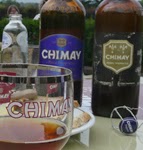Hops A-Z: H is for Humulus Lupulus
The Common Hop: species of the genus Humulus, the family Cannabaceae and the order Rosales. A native plant to Britain, Humulus lupulus var. lupulus is a perennial herbaceous plant with fast growing shoots, course-toothed leaves and flower clusters known as strobiles or cones. Inside those cones are bracts; in those bracts are glands covered in a powdery substance that are resinous and bitter and just what the brewer needs - lupulin.
Growing anywhere up to fifty feet, the hop bine is a stiff stem with hooked hairs enabling it to clutch and grow. It places roots up to four feet deep to allow for rapid vertical growth, often trained around poles to guide its growth. The flowers on each plant are either male or female (making it a dioecious species); it's the female plant that carries the sought-after cone.
As for that name - some say it derives from 'humus' as in rich, moist ground (not the dip that tastes like wallpaper paste). Lupulus is said to derive from the Latin for would (lupus); Pliny the Elder may or may not have said that it was named such because the plant 'strangled osiers like a wolf does to a sheep'. The word 'hop' itself seems to have a tortured etymology; perhaps Old English/Middle Dutch hoppe (or not), perhaps Anglo-Saxon hoppon (given as meaning 'to climb', so I'd like to believe it. Sounds too twee to me, though).
However it got its name, humulus lupulus is a plant that has been put to many uses, such as eating the shoots as if it were asparagus, dyeing cloth or as a herbalist remedy. I'm just glad that some bright spark had the idea of chucking a few into beer just so see what happens. As for who that was - that's another story.
Growing anywhere up to fifty feet, the hop bine is a stiff stem with hooked hairs enabling it to clutch and grow. It places roots up to four feet deep to allow for rapid vertical growth, often trained around poles to guide its growth. The flowers on each plant are either male or female (making it a dioecious species); it's the female plant that carries the sought-after cone.
As for that name - some say it derives from 'humus' as in rich, moist ground (not the dip that tastes like wallpaper paste). Lupulus is said to derive from the Latin for would (lupus); Pliny the Elder may or may not have said that it was named such because the plant 'strangled osiers like a wolf does to a sheep'. The word 'hop' itself seems to have a tortured etymology; perhaps Old English/Middle Dutch hoppe (or not), perhaps Anglo-Saxon hoppon (given as meaning 'to climb', so I'd like to believe it. Sounds too twee to me, though).
However it got its name, humulus lupulus is a plant that has been put to many uses, such as eating the shoots as if it were asparagus, dyeing cloth or as a herbalist remedy. I'm just glad that some bright spark had the idea of chucking a few into beer just so see what happens. As for who that was - that's another story.





















0 comments: